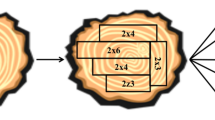Abstract
In the Canadian’s lumber industry, simulators are used to predict the lumbers resulting from the sawing of a log at a given sawmill. Giving a log or several logs’ 3D scans as input, simulators perform a real-time job to predict the lumbers. These simulators, however, tend to be slow at processing large volumes of wood. We thus explore an alternative approximation techniques based on the Iterative Closest Point (ICP) algorithm to identify the already processed log to which an unseen log resembles the most. The main benefit of the ICP approach is that it can easily handle 3D scans with a variable number of points. We compare this ICP-based nearest neighbour predictor, to predictors built using machine learning algorithms such as the K-nearest-neighbour (kNN) and Random Forest (RF). The implemented ICP-based predictor enabled us to identify key points in using the 3D scans directly for distance calculation. The long-term goal of this on-going research is to integrated ICP distance calculations and machine learning.
Access this chapter
Tax calculation will be finalised at checkout
Purchases are for personal use only
Similar content being viewed by others
References
FPInnovations: Optitek 10. User’s Manual (2014)
Morin, M., Paradis, F., Rolland, A., Wery, J., Gaudreault, J., Laviolette, F.: Machine learning-based metamodels for sawing simulation. In: Proceedings of the 2015 Winter Simulation Conference, pp. 2160–2171 (2015)
Fix, E., Hodges, J.: Discriminatory analysis. Nonparametric discrimination: consistency properties. Technical report, DTIC Document (1951)
Breiman, L., Friedman, J., Olshen, R., Stone, C.: Classification and Regression Trees. Chapman and Hall, Belmont, CA (1996)
Breiman, L.: Random forests. Mach. Learn. 45(1), 5–32 (2001)
Besl, P., McKay, N.: A method for registration of 3-D shape. IEEE Trans. Pattern Anal. Mach. Intell. 14(2), 239–256 (1992)
Chen, Y., Medioni, G.: Object modelling by registration of multiple range images. Image Vis. Comput. 10(3), 145–155 (1992)
NLGA Standard Grading Rules For Canadian Lumber (2014 edn.)
Blais, G., Levine, M.: Registering multiview range data to create 3D computer objects. IEEE Trans. Pattern Anal. Mach. Intell. 17(8), 820–824 (1995)
Bakir, G., Hofmann, T., Scholkopf, B., Smola, A.J., Taskar, B., Vishwanathan S.V.N.: Predicting Structured Data. MIT press (2007)
Author information
Authors and Affiliations
Corresponding author
Editor information
Editors and Affiliations
Rights and permissions
Copyright information
© 2018 Springer International Publishing AG
About this chapter
Cite this chapter
Selma, C., Bril El Haouzi, H., Thomas, P., Gaudreault, J., Morin, M. (2018). An Iterative Closest Point Method for Measuring the Level of Similarity of 3D Log Scans in Wood Industry. In: Borangiu, T., Trentesaux, D., Thomas, A., Cardin, O. (eds) Service Orientation in Holonic and Multi-Agent Manufacturing. Studies in Computational Intelligence, vol 762. Springer, Cham. https://doi.org/10.1007/978-3-319-73751-5_33
Download citation
DOI: https://doi.org/10.1007/978-3-319-73751-5_33
Published:
Publisher Name: Springer, Cham
Print ISBN: 978-3-319-73750-8
Online ISBN: 978-3-319-73751-5
eBook Packages: EngineeringEngineering (R0)




